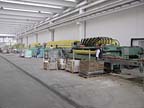

The new line is one year old, and due to the high amount of automation in the factory, only four men are required to oversee the tile line. During the production process, blocks are processed into strips on a blockcutter, and the strips are delivered to the resin line.
The resin-treating process is completely automated with machinery from Simec, and the first step is for the strips to be dried in a ventilated oven for 20 minutes at 70 degrees C. This removes all humidity and moisture from the stone and prepares it to receive the resin. A UV-activated epoxy resin from Tenax S.p.A. is applied, and it was specially formulated by Tenax to adhere to granite. After the resin is applied, the material sits in a staging area for seven minutes, and it then moves under UV light for four seconds to activate the resin.
The material is then flipped over, and the back side of the strips are calibrated on a Simec calibrator equipped with nine C3 calibrating rollers from Tenax. The material is then flipped back to its original position, and the top side is calibrated on a Simec unit with nine tangential metal-bonded, 14-cm Tenax heads that remove the resin from the surface.
After being calibrated, the final polish is applied with a Simec NP 600 RX unit that has 18 polishing heads and is equipped with a combination of Finegrain and regular abrasives from Tenax. Material moves through the polishing line at a speed of 7 meters per minute.
Once the final polish has been achieved, the strips move to a Simec cross cutting machine to be cut into tiles, and then the edges are beveled. After this step, the tiles are treated with Tenax Pectro, which removes any imperfections on the surface of the tile.
Quality control personnel mark each tile for first, second or third quality, and a scanner is able to read the markings and separate the tiles according to classification. The finished tiles are automatically boxed and placed on palettes with machinery from Nuovafima, and they are shipped to destinations around the world.